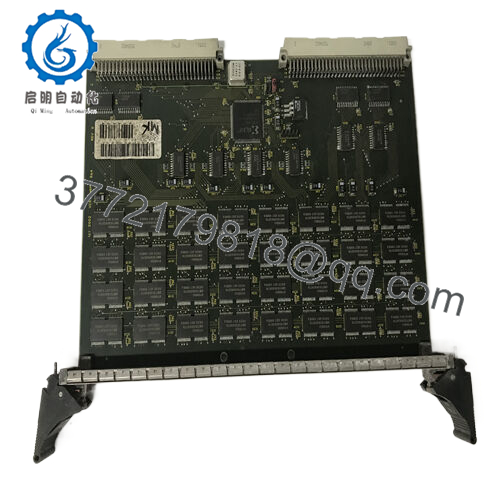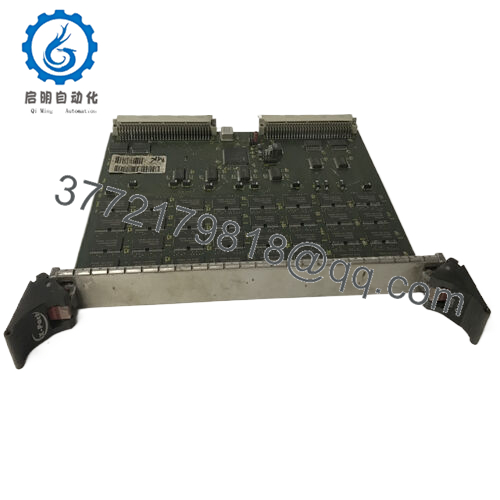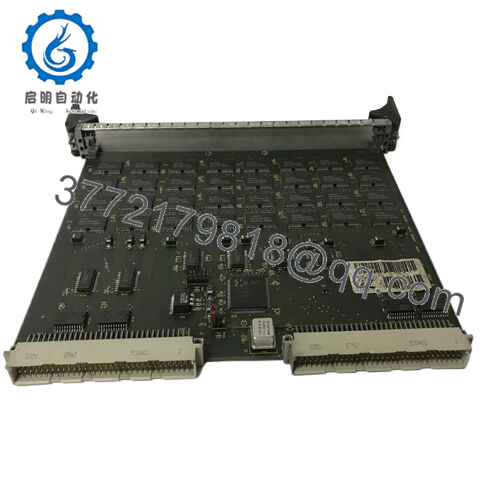Description
In the intricate web of industrial automation, the backbone of any robust control system often hinges on a capable central processor that can orchestrate data flows, execute real-time algorithms, and interface seamlessly with peripherals—all without faltering under heavy computational loads or environmental stresses. Consider a gas turbine control setup where fluctuating fuel inputs demand split-second adjustments to ignition timing, or a large-scale testbed simulating aerospace dynamics that requires synchronizing hundreds of I/O points across distributed nodes; here, sluggish bus arbitration or memory bottlenecks can snowball into delayed responses, system instability, or outright failures in process control loops. These challenges are endemic in high-reliability environments like power generation facilities or scientific instrumentation labs, where legacy VME architectures persist but demand upgrades to handle denser data streams without full-scale overhauls, leaving engineers to balance performance gains against integration risks.
The GE VMER-64 addresses this head-on as a 64-bit VMEbus processor board, engineered to inject high-speed processing power into modular VME systems while preserving compatibility with established I/O ecosystems. It targets the essential goal of scalable computation in industrial automation, leveraging its 64-bit interface for burst transfers up to 80 MB/s, which is a lifeline when retrofitting DCS panels or expanding SCADA nodes in vibration-riddled enclosures. For deployments in EMI-dense zones—think turbine halls with arcing relays or labs with pulsed power sources—the GE VMER-64 becomes non-negotiable, its flexible I/O ports enabling direct hooks to encoders, actuators, or legacy serial devices without protocol converters, thus streamlining signal paths and minimizing latency in critical chains.
Beyond the immediate fix, unreliable central processing erodes the fabric of predictive maintenance and fault-tolerant designs: jittery interrupts skew event sequencing, while limited throughput hampers historian logging, complicating root-cause forensics in post-incident reviews. With onboard memory up to 512 MB and DMA controllers that offload the CPU for concurrent tasks, the GE VMER-64 fosters deterministic execution, empowering tighter synchronization in multi-board crates and reducing the overhead of custom middleware. It’s the catalyst for evolving VME setups toward hybrid edge computing, where high-fidelity data handling ensures every cycle contributes to operational resilience rather than reactive patches.
- VMER-64
When weaving the GE VMER-64 into your VME framework, think of it as the command hub that elevates a passive backplane into an active nerve center—it occupies a single double-height slot in standard VME64 crates, drawing +5V and +12V from the P1/J1 connectors while asserting bus mastery through its VME64x-compliant arbiter, complete with geographical addressing for plug-and-play slot detection. At its core, a PowerPC or compatible 64-bit MPU crunches instructions at clock speeds north of 300 MHz, dispatching them via dual-ported SRAM to peripherals like frame grabbers or A/D converters, all orchestrated through the DTACK/IREQ lines for low-jitter handshakes in real-time kernels such as VxWorks or LynxOS.
In a typical integration, you’d populate it in slot 1 of a VMIVME-7750 chassis, configuring boot ROM for network loads over Ethernet if fitted, then mapping A64/D64 space for high-bandwidth DMA to downstream slaves—say, funneling processed sensor data to a host PLC via reflective memory rings. This positions the GE VMER-64 at the apex of your stack’s control layer, bridging raw field I/O to supervisory analytics with support for interrupts from up to seven levels, plus error-correcting ECC on memory arrays to nix soft faults in radiation-prone sites. It dovetails with backplane protocols like VSB for inter-crate extensions, and its onboard timers enable precise pulse generation for synchronized acquisitions, adapting fluidly to architectures from radial test arrays to looped control networks. Configuration via JTAG or serial console lets you tune cache hierarchies or enable hot-swap without crate power-downs, making the GE VMER-64 a versatile linchpin that amplifies system cohesion without dictating redesigns.
| Specification | Details |
|---|---|
| Model Number | VMER-64 |
| Brand | GE Fanuc VMIC |
| Type | 64-bit VMEbus Processor Board |
| Input Voltage | +5 V DC / +12 V DC (backplane) |
| Operating Temp Range | 0°C to +60°C |
| Mounting Style | VME Double-Height Slot |
| Dimensions | 340 x 133 mm (Eurocard) |
| Weight | 0.6 kg |
| Interface/Bus | VME64x (A64/D64, 80 MB/s) |
| Compliance | VITA 1.1, IEEE 1014, CE, UL |
| Supported Protocols | VME Interrupts, DMA, Ethernet (opt.) |
| Typical Power Draw | 15 W |
Harnessing the GE VMER-64 fortifies your core processing with a resilience that’s purpose-built for endurance, where its 64-bit addressing spans vast memory maps to accommodate sprawling datasets from turbine telemetry, ensuring fault isolation doesn’t cascade into full-system resets— a direct win for uptime in process control realms where seconds of delay equate to thousands in lost output. This isn’t mere horsepower; it’s the calibrated poise that sustains cache hit rates above 95% during peak loads, stabilizing algorithms for vibration compensation or load balancing without the thermal throttling that hampers lesser boards, thereby extending mean-time-between-failures in dusty or humid enclosures.
The ripple to maintenance is profound: integrated BIST (built-in self-test) routines, invocable via front-panel switches, surface memory scrubs or bus parity errors in under a minute, empowering field techs to validate integrity without external probes and curtailing diagnostic downtime by orders of magnitude in multi-crate arrays. It eases integration burdens too, with driver stacks that conform to POSIX standards, slashing qualification cycles for RTOS ports and freeing engineering cycles for value-driven tweaks like adaptive filtering. Engineered for conformal-coated durability, the GE VMER-64 guarantees long-term performance across a decade of thermal excursions, holding clock accuracy to within 50 ppm so your timing-critical sequences—like sync pulses for phased-array radars—remain impervious to drift.
For forward-leaning operations, its optional PMC site unlocks mezzanine expansions for fiber optics or FPGAs, paving seamless paths to IIoT gateways without crate evictions, which dials down total cost of ownership by amortizing legacy investments over emerging paradigms. In sum, this board doesn’t just compute; it conserves momentum, channeling computational depth into tangible gains in efficiency and foresight.
In gas turbine power plants, the GE VMER-64 drives sequence controls for startup sequencing and overspeed protection, where process control environments require high reliability amid acoustic blasts and oil mists—racked in climate-controlled cabinets, its DMA channels shuttle vibration spectra from accelerometers in real-time, upholding critical system uptime for baseload generation where a processor hiccup could spike emissions beyond regs. Its robust VME arbitration coordinates with I/O slaves for fuel valve modulation, thriving in fast data cycles tied to governor loops.
Scientific accelerators, like particle beam lines, deploy it for timing distribution, channeling discrete triggers and analog ramps in harsh, high-vacuum conditions— the board’s ECC memory safeguards event buffers against cosmic ray flips, ensuring continuous uptime for beam delivery in experiments demanding sub-microsecond precision. In heavy machinery simulation labs, the GE VMER-64 orchestrates hydraulic actuator models, processing load cell arrays under vibrational duress to mirror real-world stresses, bolstering high reliability for validation in process control simulations that inform safety certifications.
VMIVME-7807 – Single-board computer companion for embedded hosting without external chassis
VMER-116 – 32-bit predecessor for cost-sensitive legacy migrations
VMIVME-7698 – PMC expansion carrier to augment I/O on the processor board
VMIVME-7750 – Chassis system optimized for multi-slot VME64x deployments
VMER-64-ETH – Ethernet-enhanced variant for networked real-time extensions
VMIVME-1182 – Digital I/O module to pair for peripheral expansion
VMIVME-3118 – Analog output sibling for closed-loop actuation interfaces
Before easing the GE VMER-64 into your VME enclosure, scope the backplane’s slot geography—aim for an unmonarch position if multi-master, and gauge +5V capacity since boot-time inrush can hit 20W transients; a scope on the power pins during bench power-up confirms ripple stays below 100 mV. Verify VME64x conformance with a protocol analyzer if mixing vendors, and preload the EPROM with your RTOS image via JTAG to bypass netboot dependencies during initial smoke tests. For fields with grounded shields, route them to the frame ground lug per the silkscreen to preempt common-mode noise, and document jumper settings for cache size against your workload profile to avert cold-boot anomalies.
Once operational, maintenance leans observational: weekly, trigger a self-test via the utility partition and parse logs for ECC corrections—thresholds over 1% warrant a RAM refresh—while quarterly edge-connector audits with a loupe spot fretting in high-cycle slots, remedied by isopropyl swaps sans full depower. GE prescribes biannual full-system stress with synthetic loads, clocking CPU utilization to benchmark against as-shipped vectors, ideally logging DMA throughput via the VME console for trend spotting. In federated setups, script remote health pings over optional Ethernet to harvest temperature deltas, flagging fan failures before they cook the core. This calibrated oversight keeps the board primed, intruding lightly on your rhythm while amplifying diagnostic foresight.






 WhatsApp: +86 16626708626
WhatsApp: +86 16626708626 Email:
Email:  Phone: +86 16626708626
Phone: +86 16626708626



